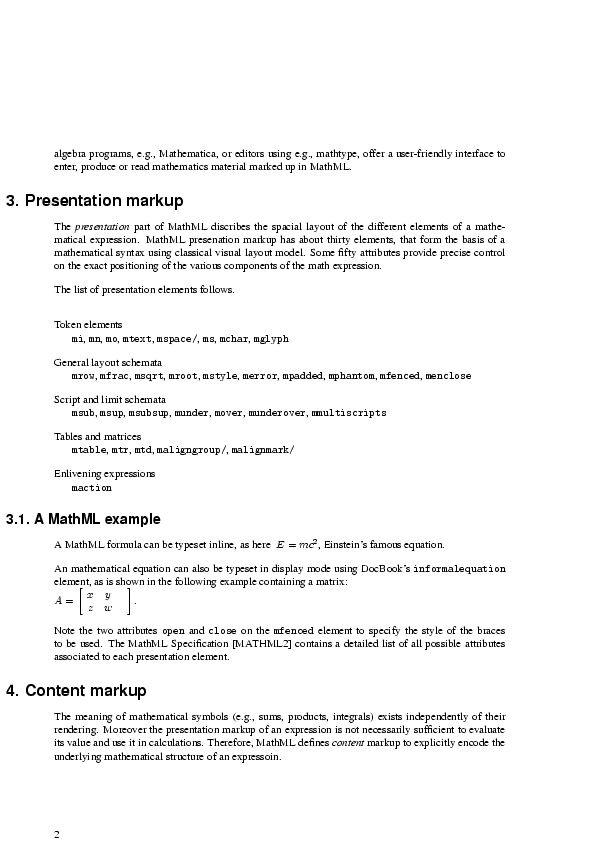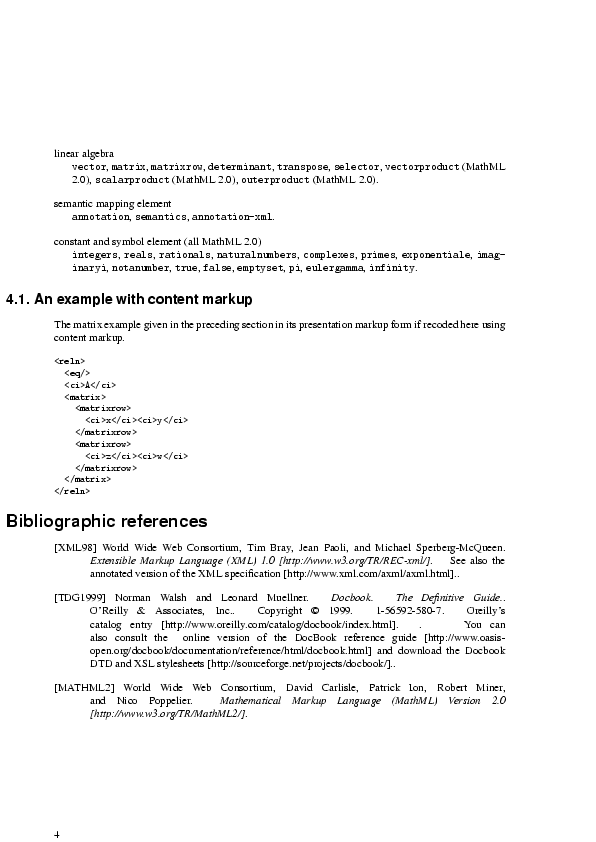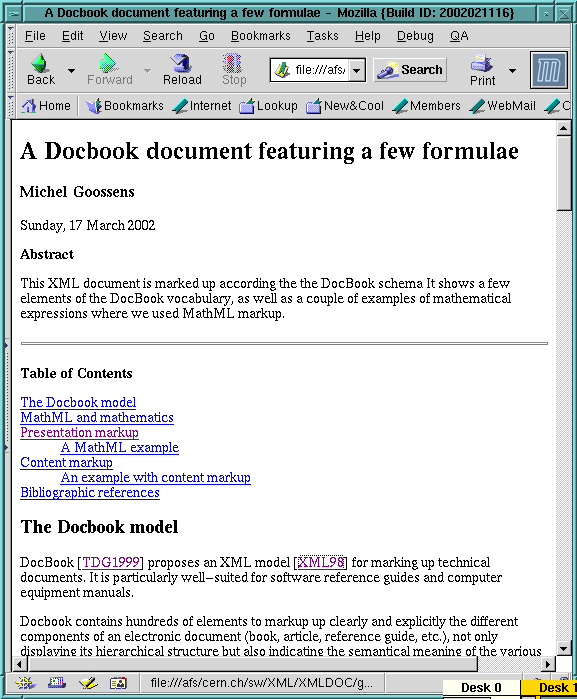1 <?xml version="1.0" encoding="ISO-8859-1"?> <!DOCTYPE article SYSTEM "/afs/cern.ch/sw/XML/XMLBIN/share/www.oasis-open.org/docbook/xmldtd-4.2/docbookx.dtd" [ 5 <!ENTITY LaTeX "LaTeX"> <!ENTITY TeX "TeX"> <!ENTITY PTeX "PassiveTeX"> <!ENTITY xmltex "<application>xmltex</application>"> ]> 10 <article> <articleinfo> <title>A Docbook document featuring a few formulae</title> <author><firstname>Michel</firstname> <surname>Goossens</surname> </author> 15 <pubdate>Sunday, 17 March 2002</pubdate> <abstract> <para> This XML document is marked up according the the DocBook schema It shows a few elements of the DocBook vocabulary, as well as a couple of 20 examples of mathematical expressions where we used MathML markup. </para> </abstract> </articleinfo> 25 <sect1> <title>The Docbook model</title> <para> DocBook <citation><xref role="bib" linkend="bib.TDG99" endterm="bib.TDG99.abbrev"/></citation> proposes an XML model 30 <citation><xref role="bib" linkend="bib.xml" endterm="bib.xml.abbrev"/></citation> for marking up technical documents. It is particularly well-suited for software reference guides and computer equipment manuals. </para> 35 <para> Docbook contains hundreds of elements to markup up clearly and explicitly the different components of an electronic document (book, article, reference guide, etc.), not only displaying its hierarchical 40 structure but also indicating the semantical meaning of the various elements. The structure of the DTD is optimized to allow for customization, thus making it relatively straightforward to add or eliminate certain elements or attributes, to change the content model for certain structural groups, or to restrict the value that given 45 attributes can take. </para> <para> Norman Walsh developed a set of XSL stylesheets to transform XML 50 documents marked up using the DocBook DTD into HTML or XSL formatting objects. The latter can be interpreted by &PTeX; and &xmltex; to obtain PDF or PostScript output. </para> </sect1> 55 <sect1> <title>MathML and mathematics</title> <para> MathML <citation><xref role="bib" linkend="bib.mathml" 60 endterm="bib.mathml.abbrev"/></citation> is a W3C recommendation whose aim is to encode mathematical material for teaching and scientific communication at all levels. </para> 65 <para> MathML consists of two parts: presentation (notation) et contents (meaning). MathML permits the conversion of mathematical information into various representations and output formats, including graphical displays, speech synthesizers, computer algebra programs, other 70 mathematics typesetting languages, such as &TeX;, plain text, printers (PostScript), braille, etc. </para> <para> 75 MathML has support for efficiently browsing long and complex mathematical expressoins and offers an extension mechanism. MathML code is human readable, easy to generate and process by software applications, and well suited for editing (even though MathML syntax might appear unnecessarily verbose and complex to the human reader). 80 </para> <para> The W3C MathMl Working Group released the Second version of the the MathML Specification at the beginning of 2001. Two public initiatives 85 that allow the display of MathML code direcly and that are under active development are W3C's <application>Amaya</application> and <application>Mozilla</application>. Commercial programs, such as IBM's <application>techexplorer</application> (a plugin for <application>Netscape</application> or Microsoft's 90 <application>Internet Explorer</application>) or Design Science <application>Webeq</application> (using the Java applet technology) can display MathML formulae in present day browsers. Several computer algebra programs, e.g., <application>Mathematica</application>, or editors using e.g., <application>mathtype</application>, offer a 95 user-friendly interface to enter, produce or read mathematics material marked up in MathML. </para> </sect1> 100 <sect1> <title>Presentation markup</title> <para> The <emphasis>presentation</emphasis> part of MathML discribes the 105 spacial layout of the different elements of a mathematical expression. MathML presenation markup has about thirty elements, that form the basis of a mathematical syntax using classical visual layout model. Some fifty attributes provide precise control on the exact positioning of the various components of the math expression. 110 </para> <para> The list of presentation elements follows. <variablelist> 115 <varlistentry> <term>Token elements</term> <listitem><para> <sgmltag class="element">mi</sgmltag>,<sgmltag class="element">mn</sgmltag>, <sgmltag class="element">mo</sgmltag>,<sgmltag class="element">mtext</sgmltag>, 120 <sgmltag class="element">mspace/</sgmltag>,<sgmltag class="element">ms</sgmltag>, <sgmltag class="element">mchar</sgmltag>,<sgmltag class="element">mglyph</sgmltag> </para></listitem> </varlistentry> <varlistentry> 125 <term>General layout schemata</term> <listitem><para> <sgmltag class="element">mrow</sgmltag>,<sgmltag class="element">mfrac</sgmltag>, <sgmltag class="element">msqrt</sgmltag>,<sgmltag class="element">mroot</sgmltag>, <sgmltag class="element">mstyle</sgmltag>,<sgmltag class="element">merror</sgmltag>, 130 <sgmltag class="element">mpadded</sgmltag>,<sgmltag class="element">mphantom</sgmltag>, <sgmltag class="element">mfenced</sgmltag>,<sgmltag class="element">menclose</sgmltag> </para></listitem> </varlistentry> <varlistentry> 135 <term>Script and limit schemata</term> <listitem><para> <sgmltag class="element">msub</sgmltag>,<sgmltag class="element">msup</sgmltag>, <sgmltag class="element">msubsup</sgmltag>,<sgmltag class="element">munder</sgmltag>, <sgmltag class="element">mover</sgmltag>,<sgmltag class="element">munderover</sgmltag>, 140 <sgmltag class="element">mmultiscripts</sgmltag> </para></listitem> </varlistentry> <varlistentry> <term>Tables and matrices</term> 145 <listitem><para> <sgmltag class="element">mtable</sgmltag>,<sgmltag class="element">mtr</sgmltag>, <sgmltag class="element">mtd</sgmltag>,<sgmltag class="element">maligngroup/</sgmltag>, <sgmltag class="element">malignmark/</sgmltag> </para></listitem> 150 </varlistentry> <varlistentry> <term>Enlivening expressions</term> <listitem><para> <sgmltag class="element">maction</sgmltag> 155 </para></listitem> </varlistentry> </variablelist> </para> 160 <sect2> <title>A MathML example</title> <para> A MathML formula can be typeset inline, as here <inlineequation> 165 <mml:math> <mml:mi>E</mml:mi><mml:mo>=</mml:mo><mml:mi>m</mml:mi><mml:msup><mml:mi>c</mml:mi> <mml:mn>2</mml:mn></mml:msup> </mml:math> </inlineequation>, Einstein's famous equation. 170 </para> <para> An mathematical equation can also be typeset in display mode using DocBook's <sgmltag class="element">informalequation</sgmltag> element, 175 as is shown in the following example containing a matrix: </para> <informalequation> <mml:math> 180 <mml:mrow> <mml:mi>A</mml:mi> <mml:mo>=</mml:mo> <mml:mfenced open="[" close="]"> <mml:mtable><!-- table or matrix --> 185 <mml:mtr> <!-- row in a table --> <mml:mtd><mml:mi>x</mml:mi></mml:mtd><!-- table --> <mml:mtd><mml:mi>y</mml:mi></mml:mtd><!-- entry --> </mml:mtr> <mml:mtr> 190 <mml:mtd><mml:mi>z</mml:mi></mml:mtd> <mml:mtd><mml:mi>w</mml:mi></mml:mtd> </mml:mtr> </mml:mtable> </mml:mfenced> 195 </mml:mrow> <mml:mtext>.</mml:mtext> </mml:math> </informalequation> 200 <para> Note the two attributes <sgmltag class="attribute">open</sgmltag> and <sgmltag class="attribute">close</sgmltag> on the <sgmltag class="element">mfenced</sgmltag> element to specify the style of the braces to be used. The MathML Specification <citation><xref role="bib" 205 linkend="bib.mathml" endterm="bib.mathml.abbrev"/></citation> contains a detailed list of all possible attributes associated to each presentation element. </para> </sect2> 210 </sect1> <sect1> <title>Content markup</title> 215 <para> The meaning of mathematical symbols (e.g., sums, products, integrals) exists independently of their rendering. Moreover the presentation markup of an expression is not necessarily sufficient to evaluate its value and use it in calculations. Therefore, MathML defines 220 <emphasis>content</emphasis> markup to explicitly encode the underlying mathematical structure of an expressoin. </para> <para> 225 It is impossible to cover all of mathematics, so MathML proposes only a relatively small number of commonplace mathematical constructs, chosen carefully to be sufficient in a large number of applications. In addition, it provides a <emphasis>extension mechanism</emphasis> for associating semantics with new notational 230 constructs, thus allowing these to be encoded even when they are not in MathML content element base collection. </para> <para> 235 MathML's basic set of content elements was chosen to allow for simple coding of most of the formulas used in secondary education, through the first year of university. The subject areas targeted are arithmetic, algebra, logic and relations, calculus and vector calculus, set theory, sequences and series, elementary classical 240 functions, and statistics linear algebra. Using this basic sets more complex constructs can be built. </para> <para> 245 The list of the content elements of MathML follows. <variablelist> <varlistentry> <term>token elements</term> <listitem><para> 250 <sgmltag class="element">cn</sgmltag>,<sgmltag class="element">ci</sgmltag>, <sgmltag class="element">csymbol</sgmltag> (MathML 2.0). </para></listitem> </varlistentry> <varlistentry> 255 <term>basic content elements</term> <listitem><para> <sgmltag class="element">apply</sgmltag>,<sgmltag class="element">reln (deprecated)</sgmltag>, <sgmltag class="element">fn (deprecated for externally defined functions)</sgmltag>, 260 <sgmltag class="element">interval</sgmltag>,<sgmltag class="element">inverse</sgmltag>, <sgmltag class="element">sep</sgmltag>,<sgmltag class="element">condition</sgmltag>, <sgmltag class="element">declare</sgmltag>,<sgmltag class="element">lambda</sgmltag>, <sgmltag class="element">compose</sgmltag>,<sgmltag class="element">ident</sgmltag>. </para></listitem> 265 </varlistentry> <varlistentry> <term>arithmetic, algebra and logic</term> <listitem><para> <sgmltag class="element">quotient</sgmltag>,<sgmltag class="element">exp</sgmltag>, 270 <sgmltag class="element">factorial</sgmltag>,<sgmltag class="element">divide</sgmltag>, <sgmltag class="element">max and min</sgmltag>,<sgmltag class="element">minus</sgmltag>, <sgmltag class="element">plus</sgmltag>,<sgmltag class="element">power</sgmltag>, <sgmltag class="element">rem</sgmltag>,<sgmltag class="element">times</sgmltag>, <sgmltag class="element">root</sgmltag>,<sgmltag class="element">gcd</sgmltag>, 275 <sgmltag class="element">and</sgmltag>,<sgmltag class="element">or</sgmltag>, <sgmltag class="element">xor</sgmltag>,<sgmltag class="element">not</sgmltag>, <sgmltag class="element">implies</sgmltag>,<sgmltag class="element">forall</sgmltag>, <sgmltag class="element">exists</sgmltag>,<sgmltag class="element">abs</sgmltag>, <sgmltag class="element">conjugate</sgmltag>,<sgmltag class="element">arg</sgmltag> (MathML 2.0), 280 <sgmltag class="element">real</sgmltag> (MathML 2.0),<sgmltag class="element">imaginary</sgmltag> (MathML 2.0), <sgmltag class="element">lcm</sgmltag> (MathML 2.0). </para></listitem> </varlistentry> <varlistentry> 285 <term>relations</term> <listitem><para> <sgmltag class="element">eq</sgmltag>,<sgmltag class="element">neq</sgmltag>, <sgmltag class="element">gt</sgmltag>,<sgmltag class="element">lt</sgmltag>, <sgmltag class="element">geq</sgmltag>,<sgmltag class="element">leq</sgmltag>, 290 <sgmltag class="element">equivalent</sgmltag> (MathML 2.0),<sgmltag class="element">approx</sgmltag> (MathML 2.0). </para></listitem> </varlistentry> <varlistentry> <term>calculus and vector calculus</term> 295 <listitem><para> <sgmltag class="element">int</sgmltag>,<sgmltag class="element">diff</sgmltag>, <sgmltag class="element">partialdiff</sgmltag>,<sgmltag class="element">lowlimit</sgmltag>, <sgmltag class="element">uplimit</sgmltag>,<sgmltag class="element">bvar</sgmltag>, <sgmltag class="element">degree</sgmltag>,<sgmltag class="element">divergence</sgmltag> (MathML 2.0), 300 <sgmltag class="element">grad</sgmltag> (MathML 2.0),<sgmltag class="element">curl</sgmltag> (MathML 2.0), <sgmltag class="element">laplacian</sgmltag> (MathML 2.0). </para></listitem> </varlistentry> <varlistentry> 305 <term>theory of sets</term> <listitem><para> <sgmltag class="element">set</sgmltag>,<sgmltag class="element">list</sgmltag>, <sgmltag class="element">union</sgmltag>,<sgmltag class="element">intersect</sgmltag>, <sgmltag class="element">in</sgmltag>,<sgmltag class="element">notin</sgmltag>, 310 <sgmltag class="element">subset</sgmltag>,<sgmltag class="element">prsubset</sgmltag>, <sgmltag class="element">notsubset</sgmltag>,<sgmltag class="element">notprsubset</sgmltag>, <sgmltag class="element">setdiff</sgmltag>,<sgmltag class="element">card</sgmltag> (MathML 2.0). </para></listitem> </varlistentry> 315 <varlistentry> <term>sequences and series</term> <listitem><para> <sgmltag class="element">sum</sgmltag>,<sgmltag class="element">product</sgmltag>, <sgmltag class="element">limit</sgmltag>,<sgmltag class="element">tendsto</sgmltag>. 320 </para></listitem> </varlistentry> <varlistentry> <term>elementary classical function</term> <listitem><para> 325 <sgmltag class="element">exp</sgmltag>,<sgmltag class="element">ln</sgmltag>, <sgmltag class="element">log</sgmltag>,<sgmltag class="element">sin</sgmltag>, <sgmltag class="element">cos</sgmltag>,<sgmltag class="element">tan</sgmltag>, <sgmltag class="element">sec</sgmltag>,<sgmltag class="element">csc</sgmltag>, <sgmltag class="element">cot</sgmltag>,<sgmltag class="element">sinh</sgmltag>, 330 <sgmltag class="element">cosh</sgmltag>,<sgmltag class="element">tanh</sgmltag>, <sgmltag class="element">sech</sgmltag>,<sgmltag class="element">csch</sgmltag>, <sgmltag class="element">coth</sgmltag>,<sgmltag class="element">arcsin</sgmltag>, <sgmltag class="element">arccos</sgmltag>,<sgmltag class="element">arctan</sgmltag>, <sgmltag class="element">arccosh</sgmltag>,<sgmltag class="element">arccot</sgmltag>, 335 <sgmltag class="element">arccoth</sgmltag>,<sgmltag class="element">arccsc</sgmltag>, <sgmltag class="element">arccsch</sgmltag>,<sgmltag class="element">arcsec</sgmltag>, <sgmltag class="element">arcsech</sgmltag>,<sgmltag class="element">arcsinh</sgmltag>, <sgmltag class="element">arctanh</sgmltag>. </para></listitem> 340 </varlistentry> <varlistentry> <term>statistics</term> <listitem><para> <sgmltag class="element">mean</sgmltag>,<sgmltag class="element">sdev</sgmltag>, 345 <sgmltag class="element">variance</sgmltag>,<sgmltag class="element">median</sgmltag>, <sgmltag class="element">mode</sgmltag>,<sgmltag class="element">moment</sgmltag>. </para></listitem> </varlistentry> <varlistentry> 350 <term>linear algebra</term> <listitem><para> <sgmltag class="element">vector</sgmltag>,<sgmltag class="element">matrix</sgmltag>, <sgmltag class="element">matrixrow</sgmltag>,<sgmltag class="element">determinant</sgmltag>, <sgmltag class="element">transpose</sgmltag>,<sgmltag class="element">selector</sgmltag>, 355 <sgmltag class="element">vectorproduct</sgmltag> (MathML 2.0),<sgmltag class="element">scalarproduct</sgmltag> (MathML 2.0), <sgmltag class="element">outerproduct</sgmltag> (MathML 2.0). </para></listitem> </varlistentry> <varlistentry> 360 <term>semantic mapping element</term> <listitem><para> <sgmltag class="element">annotation</sgmltag>,<sgmltag class="element">semantics</sgmltag>, <sgmltag class="element">annotation-xml</sgmltag>. </para></listitem> 365 </varlistentry> <varlistentry> <term>constant and symbol element (all MathML 2.0)</term> <listitem><para> <sgmltag class="element">integers</sgmltag>,<sgmltag class="element">reals</sgmltag>, 370 <sgmltag class="element">rationals</sgmltag>,<sgmltag class="element">naturalnumbers</sgmltag>, <sgmltag class="element">complexes</sgmltag>,<sgmltag class="element">primes</sgmltag>, <sgmltag class="element">exponentiale</sgmltag>,<sgmltag class="element">imaginaryi</sgmltag>, <sgmltag class="element">notanumber</sgmltag>,<sgmltag class="element">true</sgmltag>, <sgmltag class="element">false</sgmltag>,<sgmltag class="element">emptyset</sgmltag>, 375 <sgmltag class="element">pi</sgmltag>,<sgmltag class="element">eulergamma</sgmltag>, <sgmltag class="element">infinity</sgmltag>. </para></listitem> </varlistentry> </variablelist> 380 </para> <sect2> <title>An example with content markup</title> 385 <para> The matrix example given in the preceding section in its presentation markup form if recoded here using content markup. <programlisting><reln> <eq/> 390 <ci>A</ci> <matrix> <matrixrow> <ci>x</ci><ci>y</ci> </matrixrow> 395 <matrixrow> <ci>z</ci><ci>w</ci> </matrixrow> </matrix> </reln> 400 </programlisting> </para> </sect2> </sect1> 405 <bibliography> <title>Bibliographic references</title> <biblioentry id="bib.xml"> <abbrev id="bib.xml.abbrev">XML98</abbrev> <authorgroup> 410 <author><othername>World Wide Web Consortium</othername></author> <editor><firstname>Tim</firstname><surname>Bray</surname></editor> <editor><firstname>Jean</firstname><surname>Paoli</surname></editor> <editor><firstname>Michael</firstname><surname>Sperberg-McQueen</surname></editor> </authorgroup> 415 <title> <ulink url="http://www.w3.org/TR/REC-xml/">Extensible Markup Language (XML) 1.0</ulink></title> <bibliomisc> See also the <ulink url="http://www.xml.com/axml/axml.html">annotated 420 version of the XML specification</ulink>.</bibliomisc> </biblioentry> <biblioentry id="bib.TDG99"> <abbrev id="bib.TDG99.abbrev">TDG1999</abbrev> <authorgroup> 425 <author><firstname>Norman</firstname><surname>Walsh</surname></author> <author><firstname>Leonard</firstname><surname>Muellner</surname></author> </authorgroup> <title>Docbook. The Definitive Guide.</title> <publisher> 430 <publishername>O'Reilly & Associates, Inc.</publishername> </publisher> <copyright><year>1999</year></copyright> <isbn>1-56592-580-7</isbn> <releaseinfo><ulink 435 url= "http://www.oreilly.com/catalog/docbook/index.html">Oreilly's catalog entry</ulink>. </releaseinfo> <bibliomisc> You can also consult the <ulink url= 440 "http://www.oasis-open.org/docbook/documentation/reference/html/docbook.html"> online version of the DocBook reference guide</ulink> and download the <ulink url="http://sourceforge.net/projects/docbook/">Docbook DTD and XSL stylesheets</ulink>.</bibliomisc> </biblioentry> 445 <biblioentry id="bib.mathml"> <abbrev id="bib.mathml.abbrev">MATHML2</abbrev> <authorgroup> <author><othername>World Wide Web Consortium</othername></author> <editor><firstname>David</firstname><surname>Carlisle</surname></editor> 450 <editor><firstname>Patrick</firstname><surname>Ion</surname></editor> <editor><firstname>Robert</firstname><surname>Miner</surname></editor> <editor><firstname>Nico</firstname><surname>Poppelier</surname></editor> </authorgroup> 455 <title><ulink url="http://www.w3.org/TR/MathML2/">Mathematical Markup Language (MathML) Version 2.0</ulink> </title> </biblioentry> </bibliography> 460 </article>
The result of transforming the DocBook source of this appendix into PDF (with docbook2pdf, see Example 1.6 in Section 1.7) is shown in Figure B.1.
We can also transform the DocBook source into HTML with docbook2html, as explained in Section 1.5. On the one hand, we can convert it into a single output file (as in Example 1.2), and the result is shown in Figure B.2 as displayed with the Mozilla browser. This figure corresponds to the beginning of the output file. On the other hand, Figure B.3 shows one of the chunks generated when running docbook2html with the chunk option (see Example 1.4 for an explanation). For large files it is more efficient to use chunking to allow handling of reasonably-sezed output files that have to be served over the Web.





